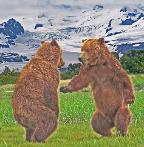CONTENTS
|
| There are currently 8 species of bears living in the world: grizzly/brown bear, North American black bear, Eurasian black bear, polar bear, sun bear, sloth bear, giant panda bear and spectacled bear. Click here for images of each species: Extinct species include the pygmy panda, Florida spectacled bear, short-faced bears and cave bear. The skeleton of the pygmy panda is very similar to that of the giant panda. Whether it is a genetically distinct species, or merely a poorly nourished race, is currently unknown. There were once several species of short-faced bears, at least one more species of spectacled bear, and several varieties of cave bear. In which regions has each species lived? China: Brown bear, Eurasian black bear, and panda bears have all lived in China; sun and sloth bears have lived nearby. This is the greatest diversity of bear species in the world – suggesting that bears first evolved in China. Malaysia, Borneo, etc.: sun bear India and Sri Lanka/Ceylon: Sloth bear Himalaya mountains north: brown and Eurasian black bear Europe:
British Isles: were once inhabited by brown and cave bears. North America:
South America:
Arctic Ocean and surrounding shores of North America and Russia, as well as several polar islands including Svalbard and Wrangle: Polar bears. During the last Ice Age, some polar bears lived as far south as Maine on the Atlantic and as Southeast Alaska on the Pacific. Currently, the farthest south they live is Hudson’s Bay. Antarctica: None. No bears have ever lived there. Had any bears ever somehow crossed from South America to Antarctica, the abundance of penguins would have provided such a wealth of food that bear numbers could have skyrocketed. The penguins only defense would be diving into the ocean – where hungry leopard seals await. So penguins would eventually be nearly exterminated. The fact that they still thrive is “proof” that bears never lived there. What’s the difference between brown and grizzly bears? Both are “arctos” bears – scientific name Ursus arctos. They can all interbreed and produce fertile offspring. So they are recognized as a single species. Polar bears evolved from brown bears. They became genetically isolated from one another because their habitats diverged at the end of an ice age -- not the most recent (Pleistocene) ice age which ended about 12,000 years ago, but one ending roughly 300,000 years ago. Polar bears normally spend most of their life on the sea ice; grizzlies spend almost no time there. Grizzlies spend virtually all of their time on land -- where polar bears seldom venture. Furthermore, the breeding season for polar bears begins about 1 month before that for grizzly/brown bears. These factors have tended to maintain genetic isolation between the species. However, now that warming of the Arctic is driving polar bears ashore even during breeding season, the chances of cross-breeding have increased dramatically. Were this situation to continue for thousands of years, polar bears and/or grizzly bears would likely evolve some mechanism that further minimizes interbreeding. All Eurasian arctos bears are called “brown” bears. Arctos bears living on the coasts of Alaska and British Columbia, where salmon abounded historically, are called “brown” bears. Those that once lived farther south on the coasts of Washington, Oregon, and California, were called “grizzly” bears, as were all living farther east. Arctos bears living on the coast of Alaska above the Arctic circle are also called "grizzlies." The “guard hairs” of a brown bear’s fur tend to be solid in color along their length. Those of a grizzly bear tend to have a light-colored tip, giving the whole coat a grey or “grizzled” like, like the beard of a middle-aged man. Arctos bears with a grizzled look are uncommon in “brown bear” habitat; arctos bears with single-color guard hairs are uncommon in “grizzly” habitat. For simplicity, throughout rest of this manual, all North American arctos bears are called “grizzlies.” Where in North America do black, grizzly and polar bears live?
See the Ghost Grizzlies text for additional details. Are polar bears the only kind of white bear? No Some black bears have a white coat. Some are albinos; they also lack pigment in their skin. Others, known as Kermodes or “spirit” bears have pigments in their skin and often some in their fur, giving it a yellowish or orangish tint. Most live on the central British Columbian coast, although few have been seen as far north as Juneau, Alaska or as far inland as Whitehorse. Some non-albino grizzly bears also have white fur. These – known as “ghost grizzlies” have been seen in the Rocky Mountains, mainly during the 1800’s. A few have also been seen in Alaska. (see the Ghost Grizzlies text.) How do you distinguish black bears from grizzly bears? Location: If you are in an area (e.g., Alaska’s North Slope) where only grizzly bears live, then any bear seen there other than a polar bear is 99.999% likely to be a grizzly. If you are within the contiguous USA away from the Rocky Mountains or the Olympics, any bear you see in the wild is 99.999% certain to be a black bear. It is only in habitats shared by the two species that you need to know more to identify the species of any bear you see. Facial profile: Seen from the side, the profile of a grizzly bear’s face tends to be “dished” between the brows and the nostrils. The tip of the nostrils rises higher than the profile of the muzzle. A black bear’s profile usually lacks this dishing. Claws: The finger claws of a black bear are short, strongly hooked and sharply tipped – which give a black bear a good grip on tree bark when climbing. The finger claws of a grizzly are much longer, straighter and blunter – which makes them effective shovels when the bear digs for plant tubers or ground squirrels. The toe claws are of similar length and shape in grizzly vs. black bears. Fur:
Ears: Those of a black bear tend to be proportionately longer than those of a grizzly. However, the apparent length of a bear's ears depends on the thickness of the fur on its head. The ears of a black bear with a heavily-furred head may appear shorter than the ears of a grizzly that has recently shed the fur off its head. Also, the larger a bear grows, the smaller its ears appear relative to the size of its head. So this is the least reliable of the clues for distinguishing grizzlies from black bears. The Ghost Grizzlies book descrobes several other differences (e.g., in shapes of the hands and feet). Profile of the back: When a bear stands four-footed on level ground, a grizzly’s shoulders are as high as or higher than its rump; for a black bear, the rump is higher than the shoulders. This is the single most reliable clue for distinguishing grizzly vs. black bears. Nevertheless, there are exceptions to each of the above "rules of thumb." For example, some grizzlies have short claws; some black bears have a shoulder hump. If you rely on just one trait, you are likely to make mistakes. However if you consider all traits and then pick the best fit, you should nearly always be right. Of course, in the wilds, you may not be able to see more than one or two clues, especially if the bear is in dense brush and you catch just glimpses. Don't jump to conclusions. Keep watching until you has seen as many features as possible. Or, if waiting is not feasible, assume it's a grizzly and take precautions accordingly. How do you distinguish a bear’s sex? Sex organs
Urination: Unlike dogs, bears do not have any special postures used during urination to distinguish males vs. females. However, when urination occurs, the urine of a male shoots forward or to the side between his legs. In fact, it may hit his legs, dribble down, and become mixed with his own scent, which then taints the soil, leaving a chemical signal for any other beat that happens by. By contrast, the urine of a female shoots backwards from the vulva below her tail. If a bear is walking as it urinates, a male’s next footfall is likely to land on ground wet with his urine; a female’s next footfall won’t. It is sometimes possible to discern in a bear’s footprint whether any urine stream landed atop the print or vice versa. How do you estimate a bear’s age or maturity? See the Ghost Grizzlies text for additional details. How do you distinguish one bear from another? See the Ghost Grizzlies text for additional details |



Identifying Bears
| Bear Viewing Association To watch, to wonder, and to conserve [email protected] Ph/Fax (907) 260-9059 (Office) 39200 Alma Ave. Soldotna, AK 99669 |


Answers to questions commonly asked by wildlife viewers on the topics listed below: |
| Bear Viewing Association To watch, to wonder, and to conserve [email protected] Ph/Fax (907) 260-9059 (Office) 39200 Alma Ave. Soldotna, AK 99669 |

